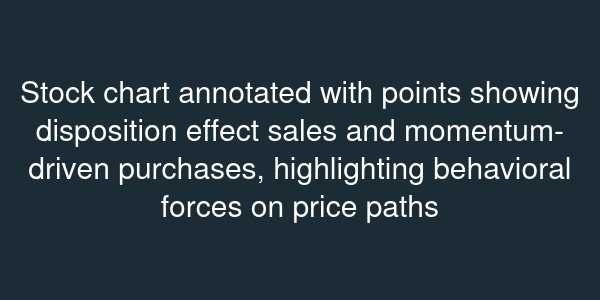Behavioral Finance
Essential Questions
- Which market patterns challenge efficient markets, and how does psychology explain them?
- How do disposition effects and momentum arise from investor behavior?
- What are the limits to arbitrage that let mispricing persist?
Overview
Stock prices should incorporate all available information. Yet we observe predictable bubbles, crashes, and patterns like momentum. Behavioral finance connects these anomalies to human biases: loss aversion, overconfidence, herding.
This lesson dissects key anomalies, uses mathematical models to show how they arise, and evaluates investment strategies and policy implications.
The Disposition Effect
Investors sell winning stocks too early and hold losers too long. Shefrin and Statman quantified this using trading data: realized gains were overrepresented relative to losses. Loss aversion explains it: selling a loser crystallizes a loss, triggering pain. We can model the probability of selling as with . Empirically, is negative for losses, reducing sale probability.
Momentum and Overreaction
Stocks that performed well over the past 3–12 months tend to outperform in the next period (momentum). Barberis, Shleifer, and Vishny model investors who underreact to earnings news (due to conservatism bias) but overreact to series of good news (representativeness). Their model generates return autocorrelations consistent with momentum followed by long-term reversals.
Mathematically, price evolves as , where captures belief errors. When investors extrapolate, stays positive, sustaining momentum.

Limits to Arbitrage
Why don't rational traders eliminate mispricing? Arbitrageurs face risks: prices can diverge before converging, and investors may withdraw capital. The "law of one price" fails in cases like the Royal Dutch/Shell dual listing, where shares traded at persistent price gaps. De Long et al.'s noise trader risk model shows that even if rational traders know the true value, they face the risk that noise traders push prices further away, leading to potential losses.
Policy and Practice
Behavioral finance informs portfolio construction. Advisors use mental accounting to create "buckets" for clients, aligning with their psychology. Regulators monitor market sentiment indicators to anticipate bubbles. Firms design default investment options, like target-date funds, to prevent inertia from harming returns.
Understanding behavioral finance helps you interpret market signals, design better investment products, and recognize when the invisible hand is swayed by invisible biases.